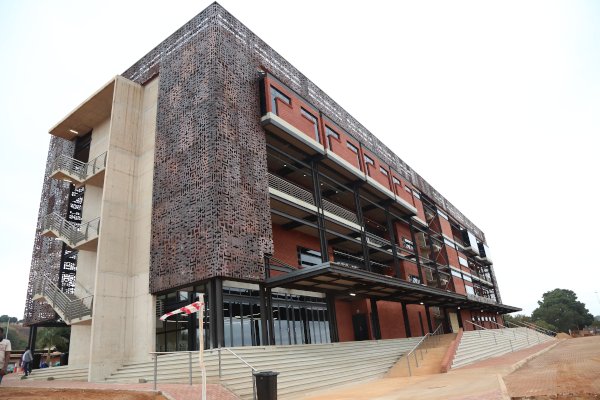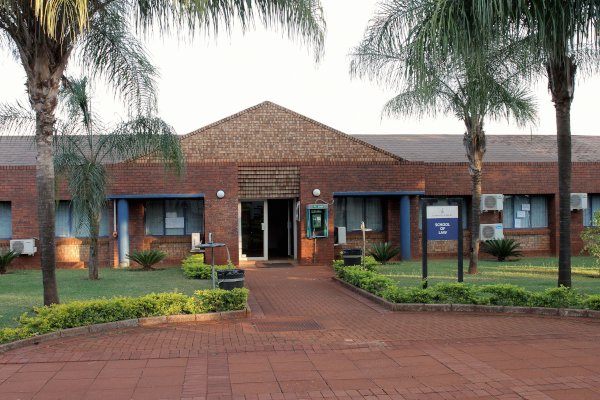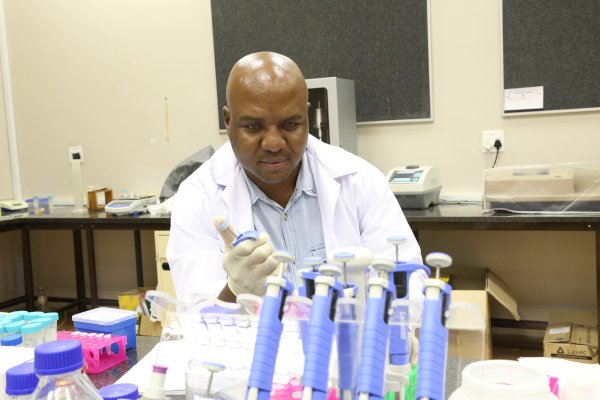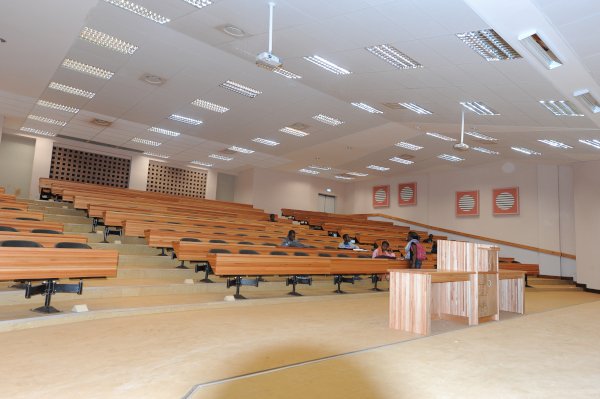Welcome to the University of Venda Institutional Repository, an open digital archive of the research output of the University of Venda. Univen IR contains theses and dissertations, research papers as well as conference papers. For further information and assistance please contact Mr Keith Malabi at +27 15 9628564 or +27 15 962 8314 during office hours
Most Viewed Items
Views
3037
929
918
554
531
526
454
447
401
397
Most Downloaded Items
Downloads
4456
3803
2193
2034
1859
1767
1737
1554
1484
1471
Recent Submissions
Development of mineral beneficiation and value addition framework for sustainable socio-economic development of Zimbabwe
(2024-09-06) Laisani, John; Amponsah - Dacosta, F.; Mulaba, A. F.
Less than a decade is remaining for African Vision 2030 which began in 2009 to lapse, yet some of its targeted developmental milestones such as mineral beneficiation and value addition are yet to be achieved. Most of the African countries richly endowed with mineral resources that are committed to incorporating beneficiation and value addition in various value chains are still lagging significantly. Zimbabwe is one country through its Zimbabwe Accelerated Sustainable Socio-Economic Transformation (ZIMASSET) economic blueprint which elaborated the multiple benefits of the beneficiation strategy to unlock value from its vast mineral resources but never developed a framework for its implementation.
This study aimed to fill that gap by developing a mineral beneficiation and value-addition framework to achieve sustainable socio-economic development in Zimbabwe. The objectives of this study were to examine the existing policies on mineral beneficiation and their effects on sustainable socio-economic development; evaluate the cross-cutting constraints and associated interventions to encourage mineral beneficiation in Zimbabwe; examine the perceptions of stakeholders regarding the need for mineral beneficiation and value addition in Zimbabwe and ultimately developing a framework for mineral beneficiation and value addition for the sustainable socio-economic development of Zimbabwe.
A mixed methods approach was used to achieve the objectives and the study design was convergent parallel design. A stratified random sampling technique was used to select 291 participants for the quantitative survey. Data was collected using a survey questionnaire and descriptive statistics were computed using SPSS version 25. An unstructured interview guide was used to collect qualitative data and themes were used to analyse the data through thematic approach. Results of the study indicate that the existing policies on beneficiation are hindering the realisation of the beneficiation and value addition of minerals. Zimbabwe’s policy volatility, policy inconsistency, bureaucracy, and corruption heavily affected the implementation of the beneficiation policy.
The cross-cutting constraints include energy constraints, lack of skills, lack of institutional capacity, lack of coordination, monitoring, and evaluation of policies, lack of appropriate legislative instruments, and the neglect of the socio-economic aspect of beneficiation. Stakeholders indicated a strong affiliation to the beneficiation strategy but there is scepticism around the current economic and political situation which is blurring the realisation of this policy. Using the above results, the framework for mineral beneficiation and value addition was developed. This framework is a critical pillar for enhancing economic value chains through beneficiation and value addition because it outlines important aspects, role players and the
resulting benefits for achieving sustainable socio-economic development in Zimbabwe. The development of the framework for mineral beneficiation and value addition in Zimbabwe implies a strategic roadmap that can guide policymakers, promote collaboration, address challenges, and pave the way for sustainable socioeconomic development through the efficient utilization of the country's mineral resources.
Innovative Extraction and Identification of Rutin Flavonoid from Moringa oleifera Leaves Using UHPLC-qTOF-MS and Computational Metabolomics Tools
(2024-09-06) Ndou, Dakalo Lorraine; Madala, N. E.; Tavengwa, N. T.; Ndlala, A. R.
Moringa oleifera is a tree that has been studied extensively and it has been found to host a variety of medicinal and nutritional properties. Owing to these properties, it has often been referred to as a ‘miracle tree’. M. oleifera contains a variety of metabolites such as flavonoids, glucosinolates, phenolic acids, tannins, and carotenoids that are responsible for the pharmacological properties of this plant. In this study, the metabolite of interest in M. oleifera was the rutin flavonoid. Rutin has various pharmacological properties and its presence in M. oleifera makes the plant more bioavailable. In this study, the presence of rutin was evaluated in M. oleifera plants in households from different villages within the Vhembe District. The Molecular Networking (MN) approach was utilized to revisit the chemical space of flavonoids in M. oleifera. The aim was to establish the biochemical modifications responsible for the chemical diversity of these compounds, which have been reported to be associated with the purported pharmacological properties of this plant. Modern extraction methods such as ultrasonic-assisted aqueous two-phase extraction (UA-ATPE) and pipette tip micro-solid phase extraction (PT-μSPE) were explored in the extraction of the most bio-available and most sought-after flavonoid, rutin, in M. oleifera leaf extracts. This work has been divided into four experimental chapters.
In Experimental Chapter 4, the presence of rutin was evaluated in the leaves of 135 M. oleifera plants from households in different villages within the Vhembe District of Limpopo Province of South Africa. The metabolite extraction was carried out using the conventional liquid extraction method using 80% MeOH and the resulting extracts were analyzed using UHPLC-qTOF-MS. The results from the UHPLC-qTOF-MS showed that only 15 plants produced rutin. This was confirmed using tandem mass spectrometry (MS2) and an authentic standard, which further validated the detected ion as a true representation of rutin. It was concluded that different cultivars of this plant are being grown in various households within the Vhembe District. These differences are expected to result in a negative perception towards Moringa plants, and as such, knowledge of the cultivar-chemical relationship should be made public with the intention to encourage the cultivation of proper plant species. The extraction of rutin from M. oleifera leaves using UA-ATPE was reviewed in Experimental Chapter 5. An ethanol/salt ATPE was formed for the extraction of rutin. Ultrasonication was used to assist in the extraction of rutin from the leaves. Central composite design (CCD) was used to design experiments and two factors which were optimized
are ultrasonic time and ultrasonic temperature. The ammonium sulphate ((NH4)2SO4), sodium chloride (NaCl), and magnesium sulphate (MgSO4) salts were used to form the ethanol/salt ATPE two phase system. The resulting Response Surface Model (RSM) was observed to be a linear fit for the ethanol/(NH4)2SO4 and the ethanol/MgSO4 ATPE systems, with R2 values of 0.7339 and 0.5782, respectively, as obtained from the analysis of variance (ANOVA). The ethanol/NaCl ATPE system yielded a quadratic fit with R2 = 0.7865 and was observed to be the best performing in the extraction of rutin from the M. oleifera leaves with optimum extraction at a temperature of 25 ºC and time of 22.5 minutes. Based on multiple reaction monitoring (MRM) through the UHPLC-qTOF-MS technique, the concentration of rutin extracted by the ethanol/NaCl ATPE system was 240 μg L-1. According to ANOVA, temperature (the B-term) was found to be the significant term with a p < 0.0500 that the extraction of rutin through UA-ATPE is temperature-dependent. Therefore, it was concluded that the extraction of rutin from M. oleifera leaves favors low temperatures. The results of the current study further demonstrate the usefulness of simple extraction techniques, such as heated water with additives like salts, as a feasible method to enrich pharmacologically relevant metabolites from plants. This reaffirms traditional protocols that are currently used by communities which include boiling plants in water to extract useful chemical compounds for the treatment of common ailments such as colds and headaches. In Experimental Chapter 6, PT-μSPE was applied in the extraction of rutin from M. oleifera leaves using activated hollow carbon nanospheres (HCNSs) as the sorbent. The activated HCNSs were characterized using FTIR, which confirmed the presence of the functional groups of interest such as OH stretch, -COO- vibration, and C=O stretch. TGA thermogram showed a difference in the thermal stability of the raw and activated HCNSs, proving that the raw HCNSs are more stable than the activated HCNSs, and SEM displayed the difference in the morphology of the raw and activated HCNSs by observing the difference in the coalescence of the material. Parameters such as loading cycles, elution solvent, concentration of rutin, pH, loading volume, and mass of sorbent were optimized. The analysis of the extracts was conducted with a UV-Vis spectrophotometer to ascertain the recovery of rutin. The optimal conditions for rutin recovery using PT-μSPE were determined to be 15 loading cycles, i-PrOH as the elution solvent, a 2 ppm as standard concentration of rutin, a pH of 2, 500 μL as loading volume, and 1.5 mg of sorbent. The LOD, LOQ, and RSD values were found to be 0.604 mg L-1, 1.830 mg L-1, and 3.26%; respectively. It was thus confirmed that the PT-μSPE method is effective in the extraction of rutin even at trace levels based on the low LOD
value obtained and the RSD value obtained proved that this method is a reliable pre-concentration technique and is thus repeatable for the analysis of complex samples. Therefore, in cases where some plants produce these compounds in minute concentrations, methods such as this one presented herein can be used to estimate and concentrate the pharmacologically relevant compounds.
Molecular networking (MN) was used to study the global metabolic profile of M. oleifera and is outlined in Experimental Chapter 7. Herein, Global Natural Products Social (GNPS) platform was used to generate the MN from the LC-MS data obtained from the methanolic leaf extracts of M. oleifera. The MN was viewed and analyzed using Cytoscape. Through MN, it was observed that M. oleifera contains a variety of metabolites. Other GNPS tools such as network annotation propagation (NAP), DEREPLICATOR, MS2LDA, and MolNetEhancer were further used to compliment the classical MN model. To this end, MS2LDA was used to annotate the flavonoids found within M. oleifera. Kaempferol, quercetin, and isorhamnetin flavonoids were successfully annotated by MS2LDA. Additionally, Chrysin-6,8-C-diglucoside was also annotated and reported for the first time in M. oleifera leaves. The results of this study further suggest MN models as useful tools for chemical exploration, enabling the discovery of new metabolites by leveraging existing knowledge as "chemical charms" to unearth hidden metabolites.
Prevalence of multi-drug resistance tuberculosis MDR-TB and associated risk factors among patients in Vhembe Region of Limpopo. South Africa
(2024-09-06) Mahamud, H.; Traore, A. N.; Potgieter, N.; Rikhotso, M. C.
BACKGROUND: The increasing prevalence of drug-resistant tuberculosis (DR-TB) poses a critical and significant obstacle in the management of tuberculosis (TB) worldwide. This driven by the emergence of multidrug-resistant tuberculosis (MDR-TB) strains and co-infection of TB with human immunodeficiency virus (HIV) have become major challenge in eradicating TB especially in low- and middle-income countries. Approximately half a million cases of rifampicin-resistant tuberculosis were reported in 2020, with 78% of these cases developing into MDR-TB.
AIM: This study aimed to investigate the prevalence of MDR-TB and its associated risk factors in Vhembe region (Limpopo, South Africa).
METHODOLOGY: A structured questionnaire was used to collect data on plausible risk factors. A total of 50 participants from the overall study were enrolled and sputum samples were obtained from patients receiving treatment from 20 healthcare facilities. Each patient blood sample was first tested for HIV using rapid test. For this study DNA was extracted from the sputum samples using reagents from multiplex real-time PCR kit (Allplex). Multiplex realtime PCR (Anyplex/ Allplex) was used to confirm the presence of TB and to detect MDR-TB respectively. MassArray was used to detect any mutation on the SNPs for rpoB and katG and inhA promoter region of the MTB.
RESULTS: Out of the 50 TB patients, 18% (9/50) were found to be MTB, 18% (9/50) to be MTB+NTM and (27/50) were NTM and 10% (5/50) could not be amplified. In this study, it was found that 2 samples were DR-TB from the patients that were MTB and MTB+NTM positive. Overall, the percentage of DR-TB was 4% (2/50). HIV prevalence in the population was 64% (32/50). The risk factors that showed high significance level of association are educational level (52%), occupation (60%), religion (80%), dusty area (72%), wearing protective mask (72%) and family support (90%). Sequence analysis showed no mutation in one patient and for the other patient the DNA not successfully genotyped.
Conclusion: There are several risk factors that are associated with TB, this includes education level, occupation, and religion. High prevalence of TB (32%) was found. However, there was low prevalence (4%) of DR-TB found (Rifampicin resistant, isoniazid resistant). Furthermore, after genotyping the resistant SNPs using MassArray, the results obtained showed that there was no mutation identified. It was observed that adolescents and young adults are more susceptible to acquiring TB and DR-TB. Timely detection of medication resistance is
imperative for the efficient management of the disease and dissemination of information related to TB and MDR-TB is vital especially in low- and middle-income countries.
Synthesis and application of ion imprinted polymers for selective extraction of metal ions from different matrices
(2024-09-06) Masindi, Muphulusi Lizzy; Mudzielwana, R.; Tavengwa, N.
Exposure to toxic metal ions such as Zn2+ and Pb2+ can lead to several diseases including cancer on human being. This study aims to synthesize Zn2+and Pb2+ ion imprinted polymers (IIPs) for removal of Zn2+ and Pb2+ from various sample matrixes. Polymerization was achieved by mixing the methacrylic acid (MAA) as a functional monomer, ethylene glycol di-methacrylate (EGDMA) as a cross-linker, azobis (isobutyronitrile) (AIBN) as initiator and methanol as a progen. The temperature was increased to 80 oC while stirring for 7 h. The identical procedure was used to make non- imprinted polymer (NIP), but no template was used. Imprinted polymers were extracted with 2 M HCl for the removal of templates.
The point of zero, or pHPZC, was determined and infrared spectroscopy was used to characterize the final products. The results of the Fourier-transform infrared (FTIR) analysis demonstrated the removal of ion templates by broad O-H peak at a wavelength of 3500 cm-1 and pHPZC results revealed that, at acidic solution, the imprinted polymers carried positive charges, and at basic solution pH, the imprinted polymers carried negative charges the PHPZC was found 6.98 and pH level was 7.0.
The maximum percentage of Zn2+ removal using the Zn-IIP was found to be 80% when the solution pH of 7.0, adsorbent dose was 5 mg, contact time at 15 min at shaking speed of 100 rpm and initial metal ion concentration of 25 mg/L were used. The adsorption kinetic data corresponded to pseudo-second order reaction kinetics with R2 = 0.99, indicating that the process occurred by chemisorption. The Langmuir isotherm showed an excellent fit with an adsorption capacity of up to 9.03 mg g-1 and R2 = 0.99, implying that adsorption was on a monolayer surface. This study shows that zinc ion imprinted polymer has higher efficiency towards Zn2+ in the solution. The finding indicates that zinc ion imprinted polymer has high adsorption efficiency of 94.00 (mg/g) in removing zinc ion from the honey sample.
The removal of Pb (II) from wastewater using Pb (II) IIP was found to be 90%. Further the re-usability study was evaluated 7 times and the adsorption efficiency was high at 90%, for this study the waste material can be beneficial for reused. The functional groups of both the imprinted polymer and the non-imprinted polymer were characterized by FTIR, and the point of zero charge was determined using the optimum conditions of 50 mg adsorbent dose, initial solution pH 9, and 15 min contact time. The adsorptive nature of the IIP and NIP was evaluated by means of Langmuir and Freundlich isotherms. The Langmuir adsorption isotherm modelled
the data better, as shown by the Langmuir and Freundlich correlation coefficients of 0.999 and 0.975, respectively.
An inventive answer has evolved in the form of ion-imprinted polymer, which was produced using the molecular imprinting approach as a basis. Higher selectivity coefficients have been demonstrated by IIPs compared to non-imprinted polymers.
Synthesis of novel 2-thiohydantoin derivatives as potential anti-diabetic drugs
(2024-09-06) Tshishonga, Unarine; Mnyakeni-Moleele, S. S.; Bvumbi, M. V.
Thiohydantoin is a hydantoin with one carbonyl group replaced with a thiocarbonyl group. In this study five series (glycinates, alaninates, butanoates, vallinates and norvalinates) of thiohydantoin derivatives (21a-v) were successfully synthesized and characterized using known analytical characterization techniques. The synthesis of these compounds followed four reaction steps using conventional methods from step one with nucleophilic substitution to Knoevenagel condensation reaction as the final step. All twenty two compounds were obtained in good to excellent yields and were subjected to in vitro screening for their inhibitory activity against α-glucosidase.
Among the five series of thiohydantoin derivatives, the alaninate derivative 21f exhibited the highest inhibition at both concentrations of 65 μM and 130 μM, with values of 71.13±0.61 and 64.20±0.54, respectively. The glycinate derivative 21j exhibited the highest inhibition of 60.95±1.07 at 130 μM, while butanoate derivatives showed a consistant moderate inhibition. Only compound 21z exhibited concentration-dependent trends of moderate inhibition on the norvallinates derivatives and the vallinates exhibited negligible inhibition.





